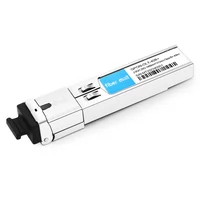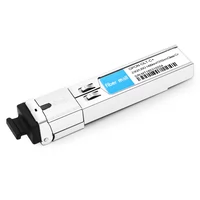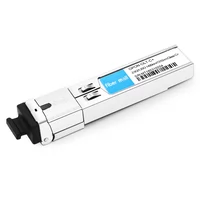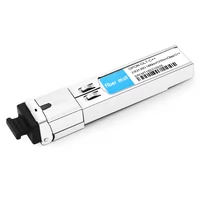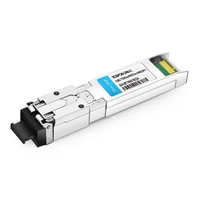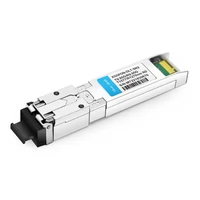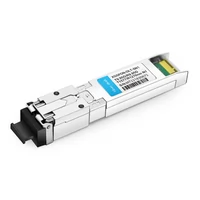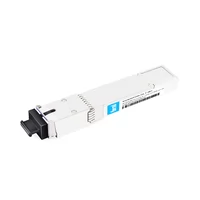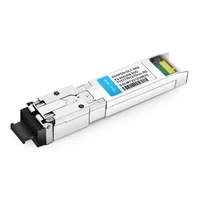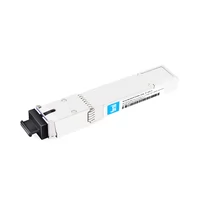In the digital era of the Internet of Everything, the Internet has become an indispensable part of life. With the improvement of the economic level, people have a higher pursuit of spiritual needs and life quality, and each family has higher requirements for the speed, stability, and coverage of the network. All these make the advent of the gigabit era an irresistible trend of the times. In the 10M era, fiber to the building; in the 100M era, fiber to the home; in the gigabit era, fiber to the room.
Table of Contents
ToggleWhat is FTTR: The Ultimate Solution for Home Gigabit WiFi Technology
FTTR (Fiber to The Room) refers to the laying of optical fibers to remote nodes, a basic technical method of optical fiber access. Other methods include FTTB, FTTC, FTTZ, and FTTH. They can be laid in a bus, ring, star, or tree topology.
FTTR is a new coverage mode of the home network in the gigabit era and is also another technological evolution and upgrade of home networking. In the past, optical fiber was used in the living room, but now it is covered in every room. With low latency, high quality, and high stability, FTTR achieves Wi-Fi 6 Gigabit coverage throughout the house.
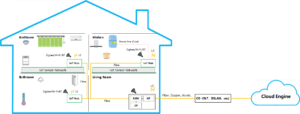
Whole-house WIFI 6 Gigabit coverage
Why do we need FTTR: full coverage of gigabit WIFI
Most users must have such questions in their minds: Why do we need FTTR when we already have WiFi? Most home broadband users’ indoor WiFi is connected to a router through an ONU (Optical Network Unit), and covered by the router’s WiFi signal. Routers support 2.4G and 5G frequency bands. Although the 2.4G frequency band can support a maximum rate of 300Mbps, the actual use effect is much worse due to the large interference in this frequency band. The high-bandwidth applications of users must use the 5G frequency band, but the WiFi signal in the 5G frequency band has a weak ability to penetrate walls, which brings great inconvenience to the high-bandwidth applications of some large-scale users.
To put it simply, if the Gigabit optical network is compared to a highway, FTTH is to pave the road to the door of the house, while FTTR is to pave the road to every room in the house. This effectively solves the problem of indoor WiFi network coverage, and at the same time solves the problem of WiFi getting stuck. The super-gigabit WiFi network with good stability covers every corner of the home and provides a five-star broadband experience–low latency, multiple connections, super high speed, and other features to meet the high-quality network needs of the whole family. People can enjoy VR movies, VR games, 4k videos, real-time meetings, and ultra-smooth online classes anytime, anywhere. A digital “Utopia” era is truly built with the balance of life and work.
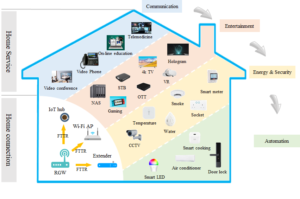
Diversified and high-quality network requirements
Advantages of FTTR: Light up a new era of gigabit
-
High bandwidth and fast internet speed
FTTR solutions deliver true gigabit bandwidth to the room.
The main ONU is connected upstream through XGSPON or 10G EPON, and the maximum rate supports 10Gbps. The slave ONU is connected to the room through optical fiber and supports a Gigabit Ethernet port and Wi-Fi6. This method avoids the performance attenuation caused by the Wi-Fi signal passing through the wall. The Wi-Fi 6 air interface rate can exceed gigabit, delivering true gigabit bandwidth to the room.
The optical fiber has the characteristics of being soft, non-oxidizing, non-corroding, and not subject to electromagnetic interference. Its service life is as long as 30 years, and one deployment can benefit for 30 years. Its bandwidth can continue to evolve to more than 100Gpbs, meeting the demands of future high-bandwidth services.
-
Simple and beautiful layout
The problem of unsightly wiring in the traditional wiring process can be easily avoided after updating to FTTR whole-house gigabit fiber. Compatible with bright and dark line networking, the line is more beautiful, which does not destroy the decoration style, and perfectly matches the home environment.
Good experience: seamless roaming,non-perceptual switching
1)Plug and Play
The master OTN is automatically connected after the slave OTN is powered on. The home Wi-Fi is unified in the master OTN and can be automatically synchronized to the slave OTN.
2)Dual-frequency automatic optimization
The whole house uses one SSID for terminal device access, and 2.4GHz and 5GHz Wi-Fi share one SSID. The FTTR main optical modem decides to select a certain frequency band for access according to the signal strength of the terminal equipment. The 5GHz frequency band is preferentially selected to ensure that the terminal equipment is in the state of optimal bandwidth carrying capacity.
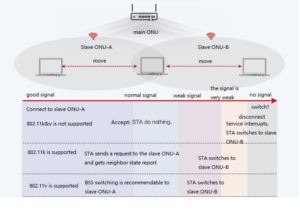
FTTR supports whole-house WiFi roaming
3)seamless roaming
There are different slave OTN access points of one SSID. When the master OTN detects that the signal strength of the wireless device is poor under the current access point, it will activate the wireless device to switch to access points with better signals within 100ms. This ensures that service is not interrupted when people move between rooms during video calls, online education, and online games.
-
Multiple terminal connections
It can support 256 terminal device connections, which is 8 times the maximum number of connections in traditional networks (the maximum number of connections in traditional networks is 8-10), which can effectively ensure that a variety of whole-house smart terminals such as computers, TVs, mobile phones, tablets, and VR can be connected to the Internet.
-
Full coverage upstairs and downstairs
FTTR whole-house smart gigabit fiber adopts the mode of 10 Gigabit OTN 1-to-N. The whole house uses optical fiber for connection, whether in the corridor or in the room. The fiber has a strong transmission capacity, a higher transmission rate, and longer network cable life. It can also support 10 Gigabit uplinks and dynamically display wide technical signals.
-
Intelligent operation and maintenance: the network can be visualized and managed
The FTTR cloud management platform can help operators improve users’ Wi-Fi experience, improve operation and maintenance efficiency, and reduce door-to-door visits. The platform identifies marketing opportunities, taps potential customers, and improves the success rate of home networking promotion through accurate insight into the home network.
The specific functions are as follows:
1) Network visibility: Visible for every user experience at every moment
Home topology and device information are visible, and 7-day history restoration is supported; key events are visible, and filtering by time and event is supported.
2)Troubleshooting: Cloud-based Wi-Fi troubleshooting, reducing door-to-door visits
Automatically identify interference, coverage, connection, and equipment faults, analyze root causes, and provide suggestions for improvement; one-click detection, and quick diagnosis of typical faults in minutes.
3) Performance tuning: Reduce Wi-Fi trouble tickets
Automatic channel tuning based on historical big data learning.
4)Insight into the features: user feature identification to support customer UC realizations.
Identify users with strong interference, poor coverage, and low device performance to support operators’ active maintenance and commercial realization.
FTTR business model
FTTR extends the optical fiber into every room. The characteristics of this solution determine that the delivery and deployment of FTTR is one of the key points to achieving a large-scale commercial launch. According to the different delivery and deployment timing, it can be divided into two scenarios:
-
“Post-decoration” scenario:
Deploy fiber optics in an already occupied house. In this scenario, the distribution of information points in the room cannot be changed, and the distribution of hidden pipes in the house wall cannot be changed. Optical fiber laying is generally carried out in the presence of network cables and coaxial cables in the hidden pipes which requires higher pipe penetration skills of construction personnel. There may also be situations where there is no dark pipe or the dark pipe cannot be penetrated. In this case, only open wires can be deployed, and in rare cases, they cannot be deployed.
-
“Before decoration” scenario:
Indoor optical fiber networks are deployed before users move into houses, such as during house decoration or in hardcover commercial houses. In this scenario, the distribution of information points can be planned as required. All-optical cables are routed through dark pipes, and there will be no open-line deployment. It is very easy to implement since the fibers are passed through empty pipes.
Obviously, for the project deliverer, the construction and deployment of the “before-decoration” scenario are less difficult than the “post-decoration” scenario, especially in the face of a more complex room type such as a villa. Besides, there is no risk of failure in the “before-decoration” construction. For users, the “before-decoration” scenario can ensure the reasonable planning of information points, and ensure the optimal coverage of the Wi-Fi signal to the whole house space. What’s more, all-optical cables are deployed in dark pipes, which makes it easier to ensure indoor aesthetics. Therefore, it is conducive to the better popularization of FTTR to explore the “before-decoration” business model and develop the industrial ecology.
The “before-decoration” business model involves cooperation with decoration companies and real estate companies. There are two implementation approaches. One is that operators cooperate with home improvement companies to deploy FTTR solutions when new or old houses are renovated; the other is operators cooperate with real estate developers to deploy FTTR in well-decorated commercial housing.
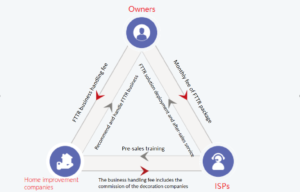
ISPs cooperate with home improvement companies
The purpose of cooperation with real estate developers is to implement FTTR solutions in batches in well-decorated houses. The ISPs can negotiate with the real estate developer to write the indoor optical fiber laying into the delivery standard of the room, and deploy the optical fiber in the room. The ISPs’ installation and maintenance personnel can conduct centralized construction and deployment to ensure the delivery quality of the optical fiber network.
In the stage of commercial housing sales, operators simultaneously carry out FTTR package marketing activities to attract homeowners to sign up for FTTR packages on the premise of the optical fiber being reserved in the room. Real estate developers can establish a certain differentiation in well-decorated houses and show the technological nature of brands through this kind of cooperation, while ISPs have the opportunity to develop high-value package users in batches.
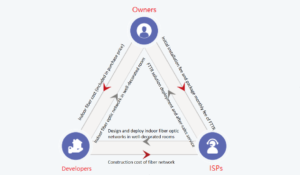
ISPs cooperate with real estate developers
In short, the “before-decoration” business model can achieve multiple wins and boost the construction of “new infrastructure” for home networks.
In comparison, the business model of the “post-decoration” scenario follows the traditional ISP 2C business model, and the industrial ecology will not undergo major changes.
Conclusion:
Looking forward to the future, FTTR can build a leading home information infrastructure for thousands of households with its technical superiority. The advantages include ultra-gigabit bandwidth, seamless indoor roaming, non-perceptual switching, an optical network not susceptible to interference, and easy evolution. Cloud VR, 4K/8K video, online education, online office, and other application services provide the ultimate experience and provide a solid information-bearing base for subsequent innovative application services.
For ISPs, FTTR will help them establish a differentiated advantage in the home broadband business and home networking service market. In particular, the intelligent operation and maintenance of home networks have advantages that users can easily perceive compared to home networking solutions. The latter uses 2C channels such as e-commerce.
The FTTR will become a key factor in promoting the growth of home businesses and better supporting the development of the digital economy. In the future, FiberMall will work with more partners to continue to promote the application of FTTR in the all-optical industry, to fully satisfy the network demand of users in the gigabit era.
Related Products:
-
 Calix 100-01836 Compatible GPON OLT SFP TX-2.5G/RX-1.25G TX-1490nm/RX-1310nm Class B+ 40km SC SMF DDM Transceiver Modules
$30.00
Calix 100-01836 Compatible GPON OLT SFP TX-2.5G/RX-1.25G TX-1490nm/RX-1310nm Class B+ 40km SC SMF DDM Transceiver Modules
$30.00
-
 NOKIA 3FE53441BAAA Compatible GPON OLT SFP TX-2.5G/RX-1.25G TX-1490nm/RX-1310nm Class C+ 20km SC SMF DDM Transceiver Modules
$35.00
NOKIA 3FE53441BAAA Compatible GPON OLT SFP TX-2.5G/RX-1.25G TX-1490nm/RX-1310nm Class C+ 20km SC SMF DDM Transceiver Modules
$35.00
-
 Ubiquiti UF-GP-C+ Compatible GPON OLT SFP TX-2.5G/RX-1.25G TX-1490nm/RX-1310nm Class C+ 20km SC SMF DDM Transceiver Modules
$30.00
Ubiquiti UF-GP-C+ Compatible GPON OLT SFP TX-2.5G/RX-1.25G TX-1490nm/RX-1310nm Class C+ 20km SC SMF DDM Transceiver Modules
$30.00
-
 Huawei GPON-OLT-CLASS C++ Compatible GPON OLT SFP TX-2.5G/RX-1.25G TX-1490nm/RX-1310nm Class C++ 20km SC SMF DDM Transceiver Modules
$32.00
Huawei GPON-OLT-CLASS C++ Compatible GPON OLT SFP TX-2.5G/RX-1.25G TX-1490nm/RX-1310nm Class C++ 20km SC SMF DDM Transceiver Modules
$32.00
-
 XGSPON-ONU-C XGSPON ONU SFP+ TX-9.95G/RX-9.95G TX-1270nm/RX-1577nm N1/N2 SC DDM 0°C~70°C Optical Transceivers
$75.00
XGSPON-ONU-C XGSPON ONU SFP+ TX-9.95G/RX-9.95G TX-1270nm/RX-1577nm N1/N2 SC DDM 0°C~70°C Optical Transceivers
$75.00
-
 Nokia 3FE46232BAAA Compatible 10G SFP+ TX-9.95G/RX-9.95G, 2.488G Tx-1577nm/Rx-1270nm SN2 SC UPC DDM Optical Transceivers
$315.00
Nokia 3FE46232BAAA Compatible 10G SFP+ TX-9.95G/RX-9.95G, 2.488G Tx-1577nm/Rx-1270nm SN2 SC UPC DDM Optical Transceivers
$315.00
-
 FiberMall XGSPON-OLT-SN1 XGSPON OLT SFP+ TX-9.95G/RX-9.95G, 2.488G Tx-1577nm/Rx-1270nm SN1 SC UPC DDM Optical Transceivers
$300.00
FiberMall XGSPON-OLT-SN1 XGSPON OLT SFP+ TX-9.95G/RX-9.95G, 2.488G Tx-1577nm/Rx-1270nm SN1 SC UPC DDM Optical Transceivers
$300.00
-
 FiberMall XGS/GPON-OLT-IB+ XGSPON GPON Combo B+ I-temp OLT MPM SFP-DD TX-9.95G/RX-9.95G Tx-1577nm/Rx-1270nm SC DDM -40°C~85°C Optical Transceivers
$315.00
FiberMall XGS/GPON-OLT-IB+ XGSPON GPON Combo B+ I-temp OLT MPM SFP-DD TX-9.95G/RX-9.95G Tx-1577nm/Rx-1270nm SC DDM -40°C~85°C Optical Transceivers
$315.00
-
 FiberMall XGSPON-OLT-SN2 XGSPON OLT SFP+ TX-9.95G/RX-9.95G, 2.488G Tx-1577nm/Rx-1270nm SN2 SC UPC DDM Optical Transceivers
$315.00
FiberMall XGSPON-OLT-SN2 XGSPON OLT SFP+ TX-9.95G/RX-9.95G, 2.488G Tx-1577nm/Rx-1270nm SN2 SC UPC DDM Optical Transceivers
$315.00
-
 FiberMall XGS/GPON-OLT-IC+ XGSPON GPON Combo C+ I-temp OLT MPM SFP-DD TX-9.95G/RX-9.95G Tx-1577nm/Rx-1270nm SC DDM Optical Transceivers
$330.00
FiberMall XGS/GPON-OLT-IC+ XGSPON GPON Combo C+ I-temp OLT MPM SFP-DD TX-9.95G/RX-9.95G Tx-1577nm/Rx-1270nm SC DDM Optical Transceivers
$330.00

